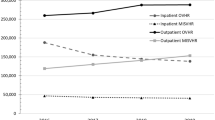Abstract
Introduction
Little is known about the predictors of increased ambulatory costs following open ventral and incisional hernia repair (VIHR); however, postoperative complications would be expected to be associated with an increased burden on outpatient resources. The purpose of this study is to evaluate the impact of perioperative factors on outpatient resource utilization following VIHR.
Methods
With IRB approval, the surgery scheduling system was queried to identify all cases of VIHR done at our institution over 3 years. Cases with other procedures done at time of VIHR were excluded. National Surgical Quality Improvement Program clinical data, physician billing data which included market and payor across cases, and medical record review data were combined and evaluated in order to quantify care and predictors of usage during the 6 months postoperatively.
Results
Data were analyzed for 308 patients. Median patient age was 52 years (SD = 13.3), and over half were female. The number of outpatient visits to the surgical office varied from 0 to 18 [median = 2; interquartile range (IQR) = 1–3]. CDC Wound Class >1 was associated with increase of mean 1.4 visits (IQR: 0.5–2.3); p = 0.003. Component separation, longer duration of operation, and increased mesh size were also predictive of increased number of office visits (p < 0.01). Postoperative infected seroma/seroma requiring drainage added a mean 2.3 visits (IQR: 1.3–3.3), (p < 0.001); and deep wound infection added a mean 3.9 visits (IQR: 1.9–5.9) (p < 0.001).
Conclusions
Postoperative complications confer a significant burden for patients and to the outpatient surgical office. In an era in which improved quality and cost-efficiency has become imperative, measures to decrease risk of postoperative complications particularly for more complex VIHR would be expected to decrease resource utilization and increase value of care.


Similar content being viewed by others
References
Poulose BK, Shelton J, Phillips S, Moore D, Nealon W, Penson D, Holzman MD (2012) Epidemiology and cost of ventral hernia repair: making the case for hernia research. Hernia 16:179–183. doi:10.1007/s10029-011-0879-9
Liang MK, Goodenough CJ, Martindale RG, Roth JS, Kao LS (2015) External validation of the ventral hernia risk score for prediction of surgical site infections. Surg Infect 16:36–40. doi:10.1089/sur.2014.115
Roth JS, Brathwaite C, Hacker K, Fisher K, King J (2015) Complex ventral hernia repair with a human acellular dermal matrix. Hernia 19:247–252. doi:10.1007/s10029-014-1245-5
Merkow RP, Ju MH, Chung JW, Hall BL, Cohen ME, Williams MV, Tsai TC, Ko CY, Bilimoria KY (2015) Underlying reasons associated with hospital readmission following surgery in the United States. JAMA 313:483–495. doi:10.1001/jama.2014.18614
Nguyen MT, Li LT, Hicks SC, Davila JA, Suliburk JW, Leong M, Kao LS, Berger DH, Liang MK (2013) Readmission following open ventral hernia repair: incidence, indications, and predictors. Am J Surg 206:942–949. doi:10.1016/j.amjsurg.2013.08.022
Perencevich EN, Sands KE, Cosgrove SE, Guadagnoli E, Meara E, Platt R (2003) Health and economic impact of surgical site infections diagnosed after hospital discharge. Emerg Infect Dis 9:196–203
Plymale MA, Ragulojan R, Davenport DL, Roth JS (2017) Ventral and incisional hernia: the cost of comorbidities and complications. Surg Endosc 31:341–351. doi:10.1007/s00464-016-4977-8
CMS.gov. Retrieved at https://www.cms.gov/medicare/quality-initiatives-patient-assessment-instruments/value-based-programs/macra-mips-and-apms/macra-mips-and-apms.html
Rosen MJ, Bauer JJ, Harmaty M, Carbonell AM, Cobb WS, Matthews B, Goldblatt MI, Selzer DJ, Poulose BK, Hansson BM, Rosman C, Chao JJ, Jacobsen GR (2017) Multicenter, prospective, longitudinal study of the recurrence, surgical site infection, and quality of life after contaminated ventral hernia repair using biosynthetic absorbable mesh: the COBRA study. Ann Surg 265:205–211. doi:10.1097/SLA.0000000000001601
Sanger PC, Hartzler A, Han SM, Armstrong CA, Stewart MR, Lordon RJ, Lober WB, Evans HL (2014) Patient perspectives on post-discharge surgical site infections: towards a patient-centered mobile health solution. PLoS ONE 9:e114016. doi:10.1371/journal.pone.0114016
Taylor EW, Duffy K, Lee K, Noone A, Leanord A, King PM, O’Dwyer P (2003) Telephone call contact for post-discharge surveillance of surgical site infections. A pilot, methodological study. J Hosp Infect 55:8–13
Meguid RA, Bronsert MR, Juarez-Colunga E, Hammermeister KE, Henderson WG (2016) Surgical risk preoperative assessment system (SURPAS): I. Parsimonious, clinically meaningful groups of postoperative complications by factor analysis. Ann Surg 263:1042–1048. doi:10.1097/SLA.0000000000001669
Leekha S, Lahr BD, Thompson RL, Sampathkumar P, Duncan AA, Orenstein R (2016) Preoperative risk prediction of surgical site infection requiring hospitalization or reoperation in patients undergoing vascular surgery. J Vasc Surg 64:177–184. doi:10.1016/j.jvs.2016.01.029 Epub 2016 Feb 27
Brooke BS, Stone DH, Cronenwet JL, Nolan B, DeMartino RR, MacKenzie TA, Goodman DC, Goodney PP (2014) Early primary care provider follow-up and readmission after high-risk surgery. JAMA Surg 149:821–828. doi:10.1001/jamasurg.2014.157
Totten CF, Davenport DL, Ward ND, Roth JS (2016) Cost of ventral hernia repair using biologic or synthetic mesh. J Surg Res 203:459–465. doi:10.1016/j.jss.2016.02.040
Majumder A, Fayezizadeh M, Neupane R, Elliott HL, Novitsky YW (2016) Benefits of multimodal enhanced recovery pathway in patients undergoing open ventral hernia repair. J Am Coll Surg 222:1106–1115
Author information
Authors and Affiliations
Corresponding author
Ethics declarations
Disclosures
Dr. Roth is a speaker for Bard, has grants with Bard, Life Cell, Gore, and MTF, and is a consultant for Life Cell. Mr. Wade, Dr. Plymale, Dr. Johnson, Dr. Davenport, Dr. Madabhushi, Mr. Tancula, and Ms. Mastoroudis have no conflicts of interest or financial ties to disclose.
Rights and permissions
About this article
Cite this article
Wade, A., Plymale, M.A., Davenport, D.L. et al. Predictors of outpatient resource utilization following ventral and incisional hernia repair. Surg Endosc 32, 1695–1700 (2018). https://doi.org/10.1007/s00464-017-5849-6
Received:
Accepted:
Published:
Issue Date:
DOI: https://doi.org/10.1007/s00464-017-5849-6




